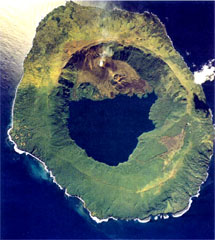Report on Tofua (Tonga) — June 2006
Bulletin of the Global Volcanism Network, vol. 31, no. 6 (June 2006)
Managing Editor: Richard Wunderman.
Tofua (Tonga) Glow seen in summit crater vent during May-June 2006 fieldwork
Please cite this report as:
Global Volcanism Program, 2006. Report on Tofua (Tonga) (Wunderman, R., ed.). Bulletin of the Global Volcanism Network, 31:6. Smithsonian Institution. https://doi.org/10.5479/si.GVP.BGVN200606-243060
Tofua
Tonga
19.75°S, 175.07°W; summit elev. 515 m
All times are local (unless otherwise noted)
Fieldwork at Tofua during 11 May-1 June 2006 was accomplished by a group led by John Caulfield (Macquarie University). The work involved detailed lithological mapping of the island, with specific focus on the N side. It is hoped that correlation of geological units and U-Series disequilibria will help to unravel the eruptive history.
The active vent, Lofia, was degassing throughout the visit. Fumaroles were located at the bottom of the vent and on the lower half of the inside of the vent. There was no degassing on the flanks of Lofia. Expelled gases were brownish-blue, with a strong sulfurous smell. The "chugging" sounds reported by Tim Worthington (BGVN 26:12) were still occurring at a rate of once every few minutes to bursts of up to four, one after the other. The highest point on the rim of Lofia was very unstable, probably weakened by the large earthquake that occurred on 4 May. A large crack (~ 30 cm wide), trending roughly WNW-ESE had opened across the thick ash and spatter deposits in the caldera, several hundred meters N of Lofia.
When the gas was periodically cleared by wind gusts, three craters could be seen at the bottom of the 150-200-m-deep vent. Of these craters, one was fumarolic, one was quiet, and one contained an orange glow. Although the depth and angle of the vent meant that the magma itself was not visible, the strong glow suggested that lava had ponded there. There was abundant spatter around the rim and abundant bombs on the flanks, the latter most likely resulting from eruptive activity in 1958. The pH of the large crater lake was determined to be 5.5-6.
Geological Summary. The low, forested Tofua Island in the central part of the Tonga Islands group is the emergent summit of a large stratovolcano that was seen in eruption by Captain Cook in 1774. The summit contains a 5-km-wide caldera whose walls drop steeply about 500 m. Three post-caldera cones were constructed at the northern end of a cold fresh-water caldera lake, whose surface lies only 30 m above sea level. The easternmost cone has three craters and produced young basaltic-andesite lava flows, some of which traveled into the caldera lake. The largest and northernmost of the cones, Lofia, has a steep-sided crater that is 70 m wide and 120 m deep and has been the source of historical eruptions, first reported in the 18th century. The fumarolically active crater of Lofia has a flat floor formed by a ponded lava flow.
Information Contacts: John Caulfield and Heather Cunningham, ARC National Key Centre for Geochemical Evolution and Metallogeny of Continents (GEMOC), Department of Earth & Planetary Sciences, Macquarie University, NSW 2109, Australia (URL: http://gemoc.mq.edu.au/); Graham Smith, Department of Earth Sciences, University of Cambridge, Downing Street, Cambridge CB2 3EQ,United Kingdom.

